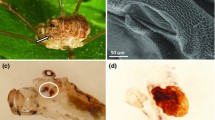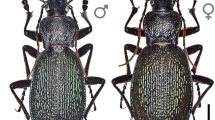Summary
North American as well as East Asian whip scorpions of the generaMastigoproctus andTypopeltis are known to use acetic acid and caprylic acid as a defense mechanism. In the secretion from defense glands of a ChineseTypopeltis species, 2-ketones (2-heptanone, 2-octanone, and 2-nonanone) were identified as constituents for the first time. While acetic acid is also present as a secretory product, no caprylic acid has been found.
Similar content being viewed by others
Abbreviations
- CI :
-
chemical ionization
- EI :
-
electron impact
- eV :
-
electron Volt
- GCMS :
-
gas chromatography-mass spectrometry
- m/z :
-
mass/charge ratio (Dalton)
References
Blum MS (1981) Chemical defenses of arthropods. Academic Press, New York, pp 138–157
Eisner T, Meinwald J, Monro A, Ghent R (1961) Defense mechanisms of arthropods. I. The composition and function of the spray of the whip scorpion,Mastigoproctus giganteus (Lucas). J Insect Physiol 6:272–298
Eisner T, Kluge AF, Carrel JE, Meinwald J (1972) Defense mechanisms of arthropods XXXIV. Formic acid and acyclic ketones in the spray of a caterpillar. Ann Entomol Soc Am 65:765–766
Itokawa H, Kano R, Kaneko S, Nakajima T, Yasahara T, Yonabaru S (1981) Chemical investigation of the spray of the Asian whip scorpionTypopeltis crucifer Pocock, 1894. Jpn J Sanit Zool 32:67–71
Jones TH, Conner WE, Kluge AF, Eisner T, Meinwald J (1976) Defensive substances of opilionids. Experientia 32:1234–1235
Jones TH, Meinwald J, Hicks K, Eisner T (1977) Characterization and synthesis of volatile compounds from the defensive secretions of some ‘daddy longlegs’ (Arachnida: Opiliones: Leiobunum spp.). Proc Natl Acad Sci USA 74:419–422
Kraepelin K (1897) Revision der Uropygi. Abh Geb Naturwiss 15:3–60
Luby JM, Regnier FE, Clarke ET, Weaver EC, Weaver N (1973) Volatile cephalic substances of the stingless bees,Trigona mexicana andTrigona pectoralis. J Insect Physiol 19:1111–1127
Schildknecht H, Berger D, Kraun D, Connert J, Gehlhaus J, Essenbreis H (1976) Defense chemistry ofStenus comma (Coleoptera: Staphylinidae). J Chem Ecol 2:1–11
Shearer JM, Boch R (1965) 2-Heptanone in the mandibular gland secretion of the honey-bee. Nature 206:530
Yogi S, Haupt J (1977) Analyse des Wehrsekretes bei dem GeißelskorpionTypopeltis crucifer Pocock. Acta Arachnol 27:53–56
Author information
Authors and Affiliations
Rights and permissions
About this article
Cite this article
Haupt, J., Höhne, G., Schwarz, H. et al. Chinese whip scorpion using 2-ketones in defense secretion (Arachnida: Uropygi). J Comp Physiol B 157, 883–885 (1988). https://doi.org/10.1007/BF00691021
Accepted:
Issue Date:
DOI: https://doi.org/10.1007/BF00691021




